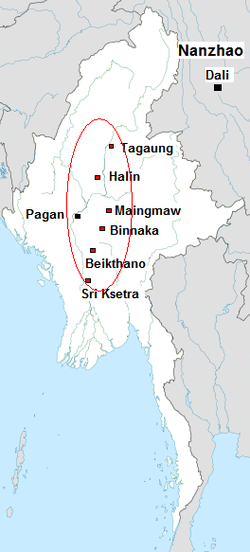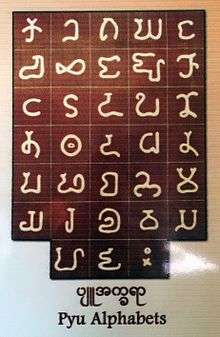Pyu language (Burma)
| Pyu | |
|---|---|
|
Pyu alphabets | |
| Region | Pyu city-states, Pagan Kingdom |
| Extinct | 13th century |
| Language codes | |
| ISO 639-3 |
pyx |
Linguist list |
pyx |
| Glottolog |
burm1262[1] |
The Pyu language (Burmese: ပျူ ဘာသာ, IPA: [pjù bàðà]; also Tircul language) is an extinct Sino-Tibetan language that was mainly spoken in present-day central Burma (Myanmar) in the first millennium CE. It was the vernacular of the Pyu city-states, which thrived between the second century BCE and the 9th century CE. Its usage declined starting in the late 9th century when the Bamar people of the Kingdom of Nanzhao began to overtake the Pyu city-states. The language was still in use, at least in royal inscriptions of the Pagan Kingdom if not in popular vernacular, until the late 12th century. It became extinct in the 13th century, completing the rise of the Burmese language, the language of the Pagan Kingdom, in Upper Burma, the former Pyu realm.[2]
The language is principally known from inscriptions on four stone urns (7th and 8th centuries) found near the Payagyi pagoda (in the modern Bago Township) and the multi-lingual Myazedi inscription (early 12th century).[3][4] These were first deciphered by Charles Otto Blagden in the early 1910s.[4]
The Pyu script was a Brahmic script. The most recent scholarship suggests the Pyu script may have been the source of the Burmese script.[5]
Classification

The Pyu language was a Sino-Tibetan language related to Old Burmese,[6] although the degree of proximity is debated. The language is tentatively classified within the Lolo-Burmese languages by Matisoff and thought to most likely be Luish (now known as Sak) by Bradley. Van Driem feels it is best treated as an independent branch of Sino-Tibetan pending further evidence.[7]
Usage
The language was the vernacular of the Pyu states. But Sanskrit and Pali appeared to have co-existed alongside Pyu as the court language. The Chinese records state that the 35 musicians that accompanied the Pyu embassy to the Tang court in 800–802 played music and sang in the Fàn (梵 "Sanskrit") language.[8]
Notes
- ↑ Hammarström, Harald; Forkel, Robert; Haspelmath, Martin; Bank, Sebastian, eds. (2016). "Burma Pyu". Glottolog 2.7. Jena: Max Planck Institute for the Science of Human History.
- ↑ Htin Aung, pp. 51–52
- ↑ Blagden, C. Otto (1913–14). "The 'Pyu' inscriptions". Epigraphia Indica. 12: 127–132.
- 1 2 Beckwith, Christopher I. (2002). "A glossary of Pyu". In Beckwith, Christopher I. Medieval Tibeto-Burman languages. Brill. pp. 159–161. ISBN 978-90-04-12424-0.
- ↑ Aung-Thwin, pp. 167–177
- ↑ Language List, PYX
- ↑ van Driem, George. "Trans-Himalayan Database". Retrieved 7 November 2012.
- ↑ Aung-Thwin, pp. 35–36
References
- Aung-Thwin, Michael (2005). The mists of Rāmañña: The Legend that was Lower Burma (illustrated ed.). Honolulu: University of Hawai'i Press. ISBN 978-0-8248-2886-8.
- Harvey, G. E. (1925). History of Burma: From the Earliest Times to 10 March 1824. London: Frank Cass & Co. Ltd.
- Htin Aung, Maung (1967). A History of Burma. New York and London: Cambridge University Press.
Further reading
- Blagden, C. Otto (1911). "A preliminary study of the fourth text of the Myazedi inscriptions". Journal of the Royal Asiatic Society of Great Britain & Ireland. 43 (02): 365–388. doi:10.1017/S0035869X00041526.
- Shafer, Robert (1943). "Further analysis of the Pyu inscriptions". Harvard Journal of Asiatic Studies. 7 (4): 313–366. JSTOR 2717831.
